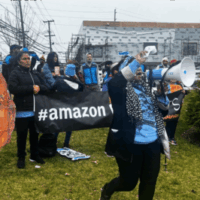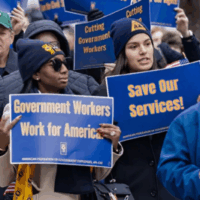Read NELP’s fact sheet on a possible statewide $15 minimum wage.
From Franklin D. Roosevelt’s pioneering legislation providing unemployment insurance and pensions for workers to Governor Andrew Cuomo’s recent push for recognition of same-sex marriage, New York has helped pave the way for civil and labor rights in this country. Governor Cuomo’s announcement that he will launch a statewide campaign to raise the minimum wage for all New Yorkers to $15 per hour marks a milestone in that proud history. New York would become the first state to adopt a $15 minimum wage, allowing an unprecedented number of struggling workers and families to take a real step towards recovery and stability with the rest of the economy.
A $15 minimum wage would allow New York to effectively tackle the most significant economic challenge facing America’s working and middle class: jobs that just don’t pay enough anymore. While the latest jobs report showed unemployment at the lowest in seven years, real median hourly wages for all workers fell by 4.0 percent from 2009 to 2014 and low-wage workers experienced an even steeper decline. Workers whose real median wages fall in the bottom 40 percent saw those wages decline by an average of 5.7 percent. Cooks and food preparation workers were hardest hit during this period with the real median wages for those occupations declining 8.9 percent and 7.7 percent, respectively. For workers in the lowest-paid jobs, these declines can mean having to choose whether to pay for utilities or groceries.
Even in low-cost regions of New York like Buffalo and Rochester, a single worker will need over $15 per hour by 2021 to meet basic living costs, according to the Economic Policy Institute’s Family Budget Calculator. In higher cost regions like Long Island, a single worker will need more than $22 an hour by 2021, according to the EPI Calculator, and workers supporting children will need even more.
New Yorkers would inevitably see and feel the benefits of Governor Cuomo’s proposed $15 minimum. Workers who earn less than $15 per hour and are not self-employed account for up to 3 million, or 37 percent, of New York’s workforce. The majority, 1.7 million, live outside of New York City. They are New York’s health aides who care for the elderly and disabled, nursing assistants, janitors and cleaners, laborers who work in warehouses to transport consumers’ goods, retail workers, and many others.
Given that about half of U.S. workers earning less than $15 per hour are 35 and older, a $15 minimum would also directly impact children and relatives who depend on minimum wage earners. Moreover, women and people of color stand to make significant gains. Women make up close to 55 percent of those making less than $15 in the U.S. even though they make up less than half of the workforce. More than half of African-American workers and close to 60 percent of Latino workers in the U.S. make less than $15 per hour.
As the fight for $15 makes headway across the country, the evidence points to a $15 minimum as a smart economic decision for both workers and broader economic growth. More than 200 economists have endorsed a $15 minimum wage, finding that “raising the federal minimum to $15 an hour by 2020 will be an effective means of improving living standards for low-wage workers and their families and will help stabilize the economy.” They conclude, too, that “costs to other groups in society will be modest and readily absorbed.” Understanding the benefits, a growing list of employers has embraced a $15 minimum wage.
Governor Cuomo’s announcement is a bold response to his state’s and this country’s deepening problem of declining wages and opportunity, and his leadership in approving a $15 minimum for the state’s fast-food workers bodes well for the millions of low-wage workers that victory leaves behind. Other states will no doubt feel new pressure to put forth their own ambitious minimum wage proposals, pushing the fight for $15 to a new level and once again showing that progressive change in New York can mean progressive change for the country.
Commentary by Laura Huizar, a staff attorney at the National Employment Law Project, and Paul Sonn, the general counsel and program director at the National Employment Law Project.
Read the original piece at CNBC.com.
Related to
The Latest News
All newsMayor Bowser & D.C. Council Must Respect the Will of D.C. Voters by Rejecting Repeal of Initiative 82

Blog
New Brief Sheds Light on the Amazon’s Dangerous ‘Flex’ Labor Model

News Release
NELP Denounces Supreme Court Ruling Permitting Immediate Layoffs of Hundreds of Thousands of Federal Workers

News Release

